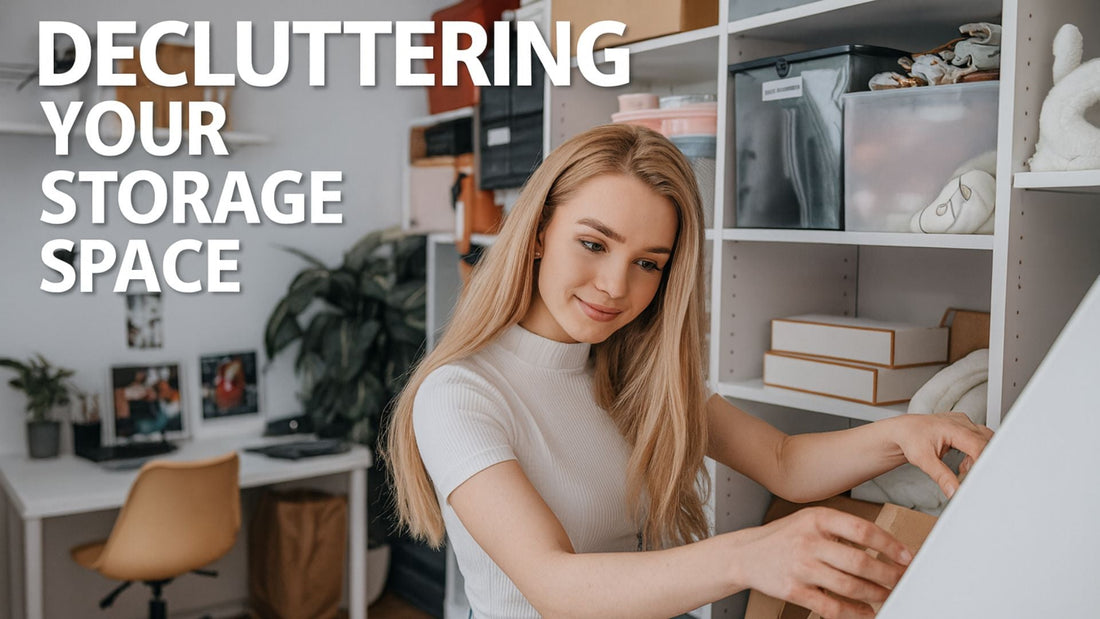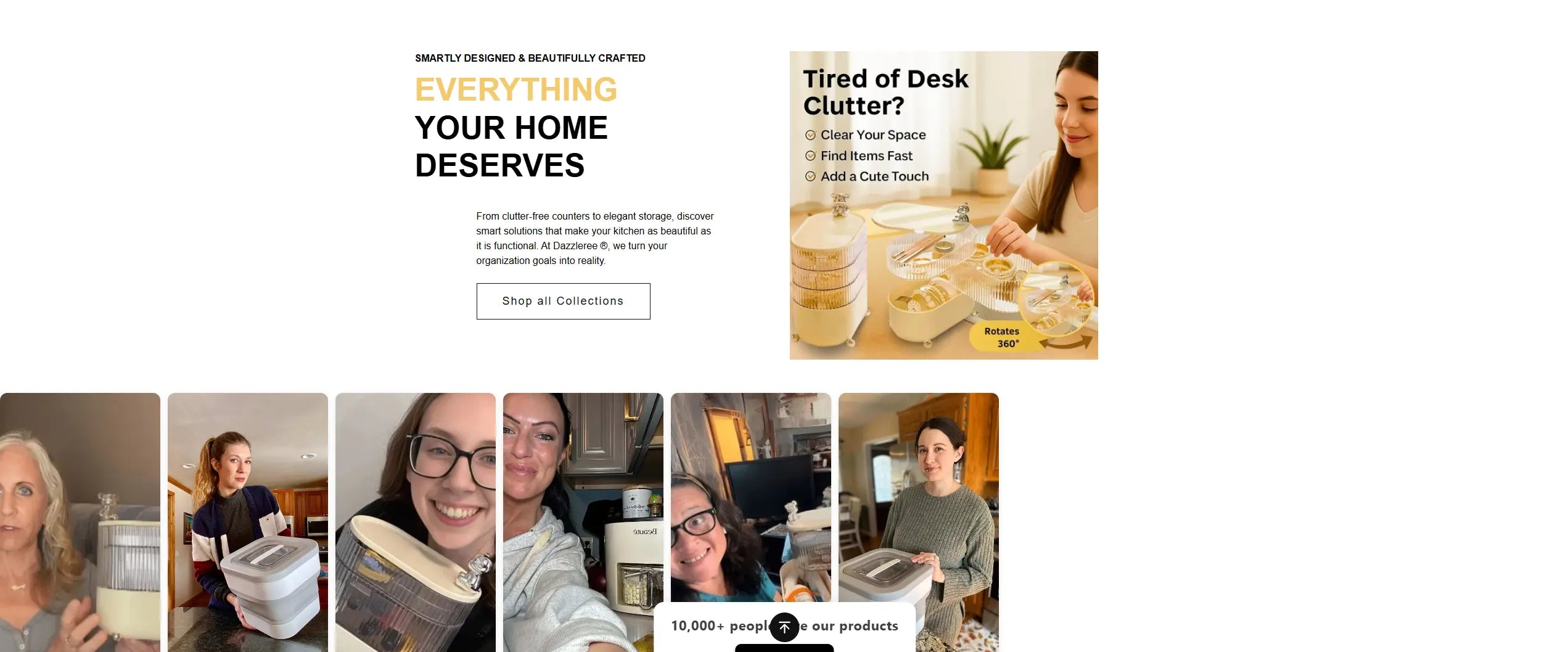
Decluttering Your Storage Space: Efficient Solutions for a Tidy Home
Share
January 26, 2025
Is your storage space a chaotic jumble of forgotten items and miscellaneous clutter? Tackling this overwhelming task may seem daunting, but with the right approach, you can transform your storage area into an organized oasis. By decluttering your storage space, you'll create a more functional and stress-free environment, making it easier to find what you need when you need it.
Start by doing a quick decluttering sweep through your storage room, identifying items that are broken, unused, or no longer serve a purpose. Sort your belongings into categories such as "keep," "donate," and "discard." This initial pass will help you gain momentum and visualize the potential of your newly organized space.
As you progress, consider implementing storage solutions that maximize your available space. Utilize containers, shelves, and organizers to keep items neatly arranged and easily accessible. Remember, the goal is to create a storage area that not only looks tidy but also functions efficiently for your specific needs.
Key Takeaways
- Decluttering your storage space improves functionality and reduces stress
- Categorize items to streamline the decluttering process
- Implement effective storage solutions to maintain organization
Understanding Clutter
Clutter can take various forms and impact our lives in profound ways. Recognizing the different types of clutter, their psychological effects, and the costs associated with disorganization is crucial for effective decluttering.
Types of Clutter
Physical clutter comprises tangible items that accumulate in your living spaces. This includes unused belongings, outdated paperwork, and redundant objects. Digital clutter refers to excessive files, emails, and apps on your electronic devices. Emotional clutter encompasses unresolved feelings or relationships that weigh you down mentally.
Time clutter involves overcommitment and poor scheduling, leading to a sense of constant busyness. Visual clutter results from an overabundance of decorative items or disorganized spaces that create visual chaos.
To identify your specific clutter challenges, assess each area of your life and note where excess accumulates. This awareness will help you target your decluttering efforts more effectively.
Psychological Effects of Clutter
Living in a cluttered environment can significantly impact your mental well-being. Clutter often leads to increased stress levels and decreased focus. You may feel overwhelmed, anxious, or unable to relax in your own space.
Clutter can also negatively affect your self-esteem and social life. You might feel embarrassed about your living conditions and avoid inviting people over. This isolation can further impact your mental health.
Removing clutter from your life can improve efficiency and free up time. A clutter-free environment promotes clearer thinking and better decision-making. You'll likely experience a sense of relief and accomplishment as you declutter, boosting your mood and motivation.
Costs of Disorganization
Disorganization can have significant financial implications. You may waste money buying duplicate items because you can't find what you already own. Late fees and penalties can accumulate due to misplaced bills or missed deadlines.
Time is another valuable resource lost to disorganization. Searching for misplaced items or navigating through cluttered spaces wastes precious minutes or hours each day. This lost time could be better spent on productive or enjoyable activities.
Clutter can also impact your professional life. A disorganized workspace may lead to missed opportunities, overlooked deadlines, or a perception of incompetence by colleagues or superiors. By addressing clutter and improving organization, you can enhance your productivity and potentially advance your career.
Decluttering Strategies
Effective decluttering strategies can transform your storage space, making it more organized and functional. These approaches help you sort through items, decide what to keep, and manage the process efficiently.
Categorization Techniques
Start by grouping similar items together. Create categories like kitchen gadgets, office supplies, or seasonal decorations. This makes it easier to see what you have and identify duplicates or unnecessary items.
Use clear bins or labels to maintain organization. Consider these categories:
- Frequently used
- Occasionally used
- Rarely used
- Sentimental
Place frequently used items in easily accessible areas. Store rarely used or sentimental items in less prime locations. This system helps you prioritize space and quickly find what you need.
Decluttering Methods
Several proven methods can guide your decluttering process:
- The 12/12/12 Rule: Find 12 items to toss, 12 to donate, and 12 to return to their proper place.
- The Four-Box Method: Label boxes as Keep, Donate, Trash, and Relocate. Sort items into these categories as you go through your space.
- The 10-10-10 Challenge: Spend 10 minutes decluttering in 10 different areas, removing at least 10 items from each.
Choose a method that suits your personality and schedule. Consistency is key to making progress.
Time Management in Decluttering
Set realistic goals for your decluttering sessions. Start with small, manageable tasks to build momentum. Try these time management techniques:
- 15-minute blitz: Set a timer and focus on one area for just 15 minutes.
- One-in, one-out rule: When you bring in a new item, remove an old one.
- Weekly maintenance: Dedicate 30 minutes each week to tidying up and preventing clutter buildup.
Schedule decluttering sessions in your calendar like any other important appointment. This helps you stay committed and make steady progress. Remember, decluttering is an ongoing process, not a one-time event.
Organizing Your Storage Space
Effective organization transforms a cluttered storage space into a functional area. Implementing smart storage solutions, utilizing vertical space, and maintaining order are key to maximizing your storage room's potential.
Effective Storage Solutions
Clear storage containers are essential for keeping items visible and accessible. Label each container clearly to quickly identify contents. Use stackable bins to make the most of floor space.
Group similar items together to create logical zones within your storage room. This makes finding and retrieving items much easier.
Consider using modular shelving units that can be adjusted as your storage needs change. These allow you to customize your space efficiently.
For smaller items, invest in drawer organizers or small boxes to prevent them from getting lost or mixed up.
Maximizing Vertical Space
Wall-mounted shelves and pegboards are excellent for utilizing vertical space. Install adjustable shelving systems to accommodate items of various sizes.
Hang bicycles, ladders, and garden tools on sturdy wall hooks to free up floor space. Over-the-door organizers can hold cleaning supplies or small tools.
Use tall, narrow shelving units to create vertical storage in corners or along walls. These are perfect for storing boxes or bins.
Consider installing a ceiling storage system for rarely-used items like holiday decorations or seasonal gear. This maximizes often-overlooked space.
Maintaining Decluttered Spaces
Implement a "one in, one out" rule to prevent accumulation. When you add a new item to storage, remove something else to maintain balance.
Schedule regular decluttering sessions, perhaps quarterly, to reassess your storage needs and remove unnecessary items.
Create a designated area for items to donate or sell. Once this area is full, take action to remove these items promptly.
Maintain your organizational system by always returning items to their assigned spots. This habit prevents clutter from building up over time.
Periodically review your storage solutions. As your needs change, be willing to adjust your organization system to keep it effective and efficient.
Tools and Equipment
Efficient decluttering requires the right tools and technological aids. These essentials will streamline your organization process and help maintain a clutter-free storage space.
Essential Decluttering Tools
Start with sturdy boxes or bins for sorting items. Label makers are invaluable for clear identification. Use a tape measure to ensure items fit in designated spaces. Microfiber cloths and all-purpose cleaners keep surfaces spotless during the process.
Heavy-duty trash bags are crucial for discarding unwanted items. Consider investing in vacuum storage bags to compress bulky textiles. A stepladder provides safe access to high shelves. Gloves protect your hands when handling dusty or sharp objects.
Don't forget a notepad and pen for inventorying items or making to-do lists. A camera or smartphone helps document items for potential sale or donation.
Technological Aids
Digital decluttering tools can revolutionize your organization efforts. Use inventory apps to track stored items, making it easy to locate things when needed. Some apps even allow you to photograph and categorize belongings.
Cloud storage services help digitize important documents, reducing physical clutter. Consider a portable scanner to quickly convert papers to digital files.
Smart labels with QR codes can link physical items to digital information. This technology allows you to access detailed inventories with a simple smartphone scan.
Task management apps help you stay on track with your decluttering goals. Set reminders, create checklists, and monitor your progress effortlessly.
Lifestyle Adaptation
Adapting your lifestyle is crucial for maintaining a clutter-free storage space. By developing sustainable habits and practicing mindful consumption, you can prevent the accumulation of unnecessary items and keep your space organized long-term.
Building Sustainable Habits
Start by establishing a regular decluttering routine. Set aside 15 minutes each week to review your storage area and remove any items you no longer need. This prevents clutter from building up over time.
Implement the "one in, one out" rule. Whenever you bring a new item into your home, remove a similar item to maintain balance. This habit helps control the influx of possessions.
Create designated spaces for frequently used items. Use labels or color-coding systems to make it easy to return things to their proper places. This reduces the likelihood of items being misplaced or forgotten.
Develop a habit of putting things away immediately after use. This simple action can significantly reduce clutter and keep your storage areas organized.
Mindful Shopping and Consumption
Before making a purchase, ask yourself if you truly need the item. Consider its long-term value and how it fits into your existing storage space. This mindful approach can lead to financial savings and prevent unnecessary accumulation.
Opt for quality over quantity. Invest in durable, multi-purpose items that serve multiple functions. This reduces the need for numerous single-use objects cluttering your storage.
Practice the 24-hour rule for non-essential purchases. Wait a day before buying to ensure it's not an impulse decision. This pause often leads to more thoughtful consumption.
Consider borrowing or renting items you'll only use occasionally. This approach saves storage space and reduces unnecessary ownership of rarely used possessions.
Regularly reassess your belongings. Ask yourself if each item still serves a purpose or brings you joy. Donate or sell items that no longer fit your lifestyle to free up valuable storage space.
Frequently Asked Questions
Decluttering and organizing your storage space can be challenging. These common questions address key aspects of the process, from budget-friendly solutions to creative space-maximizing techniques and methodical approaches for sorting items.
How can I effectively organize my storage room using budget-friendly solutions?
You can organize your storage room affordably by repurposing items you already own. Use shoe boxes to store small items, and repaint old shelving units for a fresh look. Plastic containers from discount stores work well for categorizing belongings.
Hanging organizers on the back of doors maximize vertical space. Labeling is crucial for easy identification and can be done with inexpensive tape and markers.
What are some creative ideas for maximizing space in a small storage room?
Install ceiling-mounted shelves to utilize overhead space. Use vacuum storage bags to compress bulky items like bedding and winter clothes.
Consider adding a pegboard to a wall for hanging tools and small items. Over-the-door organizers can hold cleaning supplies or office materials. Stack clear plastic bins to make contents visible and easily accessible.
What is the 20/20/20 rule for decluttering, and how can it be applied to a storage space?
The 20/20/20 rule suggests getting rid of items that cost less than $20, take less than 20 minutes to replace, and haven't been used in 20 days. In a storage space, this could mean parting with inexpensive tools, easily replaceable household items, or seasonal decorations you haven't used recently.
Apply this rule methodically, going through one category at a time. It helps you make quick decisions and reduces unnecessary clutter.
How do I start the decluttering process for a storage room that is extremely cluttered?
Begin by clearing a workspace near the entrance of your storage room. This area will serve as a sorting station. Start with one small section or category of items to avoid feeling overwhelmed.
Create four piles: keep, donate, sell, and discard. Work through items systematically, making quick decisions. Focus on progress rather than perfection.
Can you suggest a methodical approach to sorting and purging items in a storage space?
Start by categorizing items into groups like seasonal decorations, tools, memorabilia, and household goods. Tackle one category at a time, thoroughly assessing each item's value and necessity.
Ask yourself if you've used the item in the past year and if it serves a specific purpose. Be honest about sentimental items – keep only those with genuine emotional significance.
How do I start decluttering my storage room without feeling overwhelmed?
To declutter your storage room without getting overwhelmed, start small and focus on one area at a time. Set a timer for 15-30 minutes and tackle a single shelf or bin.
Remember, progress over perfection is key. As you gain momentum, gradually increase your decluttering sessions.
What's the best way to tackle sentimental items when decluttering?
When dealing with sentimental items, be gentle with yourself. Consider keeping a select few meaningful items and photographing the rest.
Ask yourself if the item brings you joy or if it's just taking up space. For items you're unsure about, create a "maybe" box and revisit it after a few months.
How can I declutter my home and get rid of storage units?
To declutter your home and eliminate the need for storage units, start by sorting items into categories: keep, donate, sell, and discard.
Be honest about what you truly need and use. For items you decide to keep, find permanent homes within your living space. Gradually empty your storage unit by bringing items home and deciding their fate.
What are some efficient ways to sell items when decluttering?
Efficient ways to sell items include using online platforms like Facebook Marketplace, eBay, or Craigslist. You can also organize a garage sale or participate in local flea markets.
For valuable items, consider consignment shops or specialty buyers. Remember to price items reasonably and take good photos to attract potential buyers.
How do I decide what to keep when I'm ready to declutter my storage?
When you're ready to declutter your storage, ask yourself these questions: Have I used this in the past year?
Does it serve a purpose in my current life? Is it easily replaceable if I need it later? Does it bring me joy? If you answer "no" to most of these questions, it's probably time to let the item go.
What should I do with items I no longer need but can't sell?
For items you can't sell, consider donating to local charities, shelters, or schools. Many organizations will pick up donations for free.
You can also offer items to friends or family, use online platforms like Freecycle, or recycle them if possible. As a last resort, look into junk removal services for items that can't be donated or recycled.
How can I maintain a clutter-free storage space after decluttering?
To maintain a clutter-free storage space, implement the "one in, one out" rule: for every new item you bring in, remove one.
Regularly reassess your belongings, perhaps seasonally, to prevent clutter from accumulating. Use clear storage containers and labels to keep items organized and easily accessible.
What are some creative storage solutions for a small home?
Creative storage solutions for small homes include using vertical space with tall shelving units, utilizing under-bed storage, installing hooks on walls or doors, and investing in multi-functional furniture like ottomans with hidden storage.
Consider vacuum-sealed bags for bulky items and use the back of doors for hanging organizers.
How do I declutter digital storage to free up space on my devices?
To declutter digital storage, start by deleting unnecessary files, photos, and apps. Use cloud storage for important documents and photos to free up device space. Unsubscribe from email lists and delete old emails.
Organize remaining files into clearly labeled folders. Regularly back up important data and perform a digital declutter session every few months.
What are some eco-friendly ways to dispose of items when decluttering?
Eco-friendly disposal methods include recycling electronics at designated centers, composting biodegradable items, and upcycling or repurposing old items into new, useful objects. Donate gently used items to reduce waste.
For hazardous materials, check with your local waste management facility for proper disposal methods. Always prioritize reusing and recycling over throwing items in the trash.


